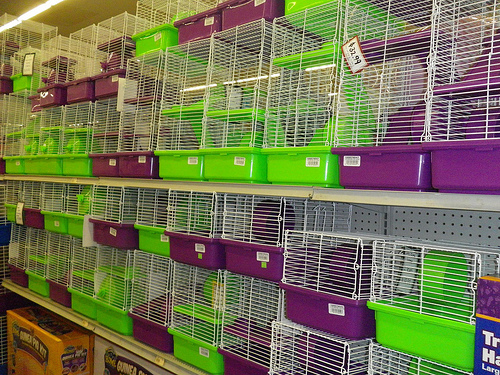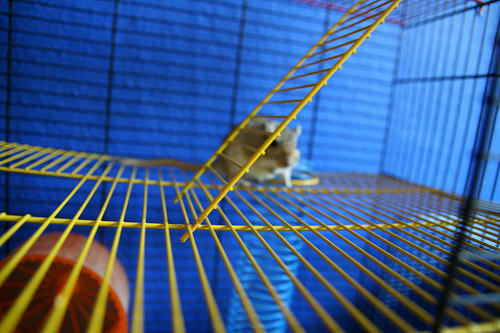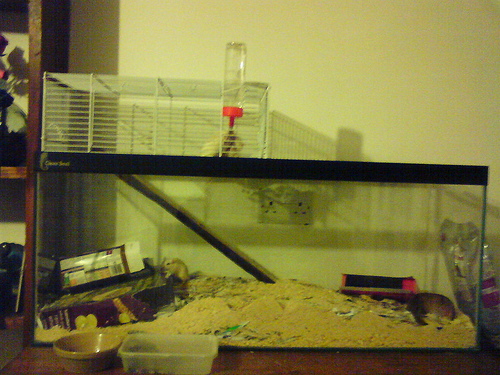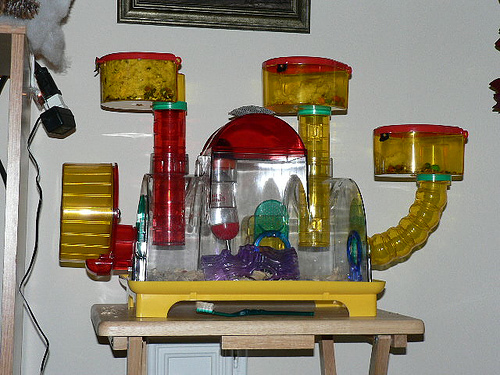What is The Best Gerbil Cage?
The best gerbil cage you can buy would be mainly a tank!
When people think of ‘a cage’ they often just use the word loosely to mean ‘something a small animal lives in’, or more precisely they use it to mean the shallow-based wire cages, usually with levels in it, a slopey ladder and lots of bars. Basically a traditional hamster home.


However, gerbils prefer to live in very different homes to hamsters as they like to do very different things to hamsters. Very different indeed.
Hamsters mainly sleep and eat; gerbils mainly dig and chew.
Hamsters live on their own; gerbils live in a clan of two or more.
Hamsters have a thin layer of bedding that they walk on the surface of; gerbils need tonnes of bedding to recreate their natural underground lifestyle and to play and dig in.
Hamsters can leave all their house and bedding intact and virtually where you left it when you last cleaned it out a week ago; gerbils will destroy everything you put in the tank, kick all the bedding all over the place and wreck the joint within hours.
So although you may have got to this article searching for the best gerbil home – using the word ‘cage’ in gerbil circles can cause a mountain of advice on how tanks are more suitable for the very reasons above.
The best gerbil cage: try a gerbilarium?
However, cages aren’t totally terrible for gerbils though – that is if you redefine the word ‘cage’ to mean something slightly different. The example image below is one of the best gerbilariums readily found in stores, useful for bonding with young gerbils.

Gone is the shallow cat litter tray bottom and in comes a deep base at least 6 inches from base to lip to replace it. On top of this base is a wire section that has various shelves and slopes – the only safe place to put things like the water bottle and wheel so they don’t become buried under a mountain of dumped bedding.
Gerbilariums with an easy-to-open top are great for getting to know your gerbils and interacting with them too. These smaller set ups (as above) are great for starting with as they will allow you to make contact with your gerbil easily by opening the little side door (you can’t do that in a giant tank).
You can easily train your gerbils to respond to you opening the door and calling their name – they will soon learn to respond if there is a treat waiting for them!
Over just a short time you will have a great bond with your gerbil and can start really making friends. Once you are happy that they are happy to be picked up, respond to their name and aren’t scared or their new home – then moving them into a larger tank can increase their play zone as well as still allowing you to interact with them.
Some people are very anti these smaller gerbilariums – but they are an incredibly useful tool for the early days with your new gerbil/s. Many people who put their new young gerbils or rescue gerbils into a substrate-filled 4 foot tank with tunnels and houses everywhere may not see them for days on end – and taking all the substrate out of the tank to catch them everytime you want to handle them won’t help with the bonding process.
Infact digging out a gerbil from its ‘safe zone’ will have the effect of making it more scared.
Best use a smaller gerbilarium short term where they can come to you and you can keep contact almost everyday to begin with, then go from there. Happier gerbils, happier keepers.
Types of Gerbilarium:
There are many of these ‘gerbilariums’ commercially available which match a gerbils requirements, clan size and space you have free for tanks, and because most are made of plastic or thinner glass – they are really light and portable compared to solid glass tanks and converted aquariums.
Really easy to clean out too – especially for families – just tip the bottom into the bin. Simple.
Search for images of these online or look at a Ferplast Karat for a very large version. There are plenty of different makes out there; some wider, some longer, some taller, some are just massive!
But, as their bases are often made of plastic, they can be quite noisy for us humans when the gerbils starts digging in them (glass digging is almost silent). Plastic bases though are also much easier to clean as 3ft or bigger shelved tanks won’t easily fit in the bath tub – and those with shelves attached inside can be fiddly to work around.


However, the wire ledges in these gerbilariums can look uncomfortable on their tiny feet so many people advise to cover them with various different things to make them flatter, like flattened bendy bridges or willow weaved sheets, etc, which work well. Cardboard can work short term, but gets visibly soiled quickly.
And don’t be fooled by a cage that has solid plastic shelves instead of wire ones though – as depending on your gerbils preferences for chewing – these may not last too long before being re-shaped (i.e. chewed to pieces) by your clan. Gerbils can still chew the wire of course, but they usually can’t break through these!
Is the best gerbil cage homemade?
Now we have seen that a gerbil needs something that resembles the top half of a cage balanced on a tank-like bottom – we could just as well make our own!
You basically choose the base of your choice – maybe a 4 ft glass tank or a really deep and wide Really Useful Box (RUB) and then add your own choice of cage to the top where it it is known in the gerbil trade forever more as a ‘Topper’.
Basically, with various amounts of tweaking and re-modelling you can perch ANY cage or cages on the top of any tank – just search online for any number of versions to use for inspiration – like below, only with much more bedding and boxes…
The reason that the topper is such a welcome addition to a tank is because gerbils dig all the time and create piles of bedding and dust everywhere – including in their food bowl, piled over their dust bath, blocking up their wheel and completely burying their water bottle and making all the bedding wet.
By using a small (or large) upstairs department – you can help eliminate all that AND make everything last longer (a part buried wheel will soon be chewed up) and stay cleaner (gerbils use their sand bath as a toilet so seiving this out regularly saves soiling the main tank) and saves you money too.


Obviously, you need to make sure that all the connecting parts are totally safe and most importantly gerbil-proof. Ideally the topper should be accessed by a nice gently sloping flat ladder or several interconnected ledges that are easy to move between and won’t be affected by the height of the substrate (as this will change all the time with their digging).
Avoid a single tube leading to the topper in clans of more than two gerbils as this can limit access to the only source of water – something that can increase the chances of a declan. A defensible tube (or other section) can mean that one or more gerbils are ‘not allowed in’ when the Boss gerbil is about, and although a certain about of Boss is normal with gerbils – ‘sections’ can cause trouble.
In fact tubes connecting different sections of ANY gerbil set up are a bad idea (see details below). Not only can they encourage declanning, they are also the weak points of a set up structurally – and noone wants an escaped gerbil…
The Best Gerbil Topper?
As said above, the topper part can be any size, height, width or depth you choose as long as it can safely and securely be connected onto the top of your tank without any gaps or sharp edges.
The topper can be fixed completely on top (like a pre-made gerbilarium) or fixed to one side (like in the image above). It can be attached to the existing tank, or can be fixed to a self-made frame, or made as part of a completely new lid.
Ideally though – don’t ever leave any part of the tank ‘open’. Gerbils can jump really high and can find a gap real fast (however they usually wait until you have gone outside or are asleep before setting about escaping…). As they can shift around their bedding real fast too – without knowing it they can move enough substrate over to one side that they make their own ramped exit slope (which has happened several times in my tanks).
Bars on toppers can be either horizontal (usually from mammal cages) or vertical (usually from bird cages) but neither are better or worse than the other as you can still connect water bottles, wheels and ledges to them all.
You don’t need to keep the wire shelves already in these cages – you can make your own out of kiln-dried pine or other safe woods and have much more gerbil-friendly set up with lots for them to do in both the topper AND tank.
Some people even make their own topper from scratch using aviary wire and some 4 by 2!
Now about these tubes?
External tubes and their respective connecting sections are well-known weak points in any gerbil home and they may help your gerbils to escape – either through chewing their way out of a weak plastic joint – or just falling out of the tube when its connectors come loose due to poorly chosen angles and connectors.
Best avoid tubes all together on the outside with gerbils – but they can be used on the inside to get between the bedding and the topper if they aren’t the only way up and down.
A low-angled slope leading up into your topper is best for this however. Gerbils are better on slopes and in tubes at a low angle than they are on ladders. Sure, they can really nip up a ladder a treat – but when they are very young and when they start to age – ladders can be unnecessarily more effort than a slope.


Do also avoid vertical tubes – as although gerbils can get up them – they aren’t designed for that type of movement and they don’t wedge themselves upwards like (larger) Syrian Hamsters can do.
They have to be quite agile to get up and down them easily, and so it can mean that less-able gerbils use them less often and so miss out on whatever you have upstairs – and if the only water bottle is up there they may drink less to save the effort.
So, the best cage for a gerbil?
The best cage for a gerbil is one that is full of enrichment, ledges and activities; which is securely perched on top of a large, deep tank filled with tunnel-friendly substrate!
Great article, thank you so much for this info.
Interesting and useful article, but you’re suggestion of starting with a smaller cage and then going to a larger cage (tank) is unnecessary hassle and expense.
If you can afford to get a bigger cage in the 1st place, then just get that, & section part of it off until they’ve bonded with you, then open it up.
Although I’m not sure that’s even necessary, surely you could attract Gerbils to or near your hand with treats and gentle noises in any size tank?
Btw, you made a typo here 😉 :-
“The Best Gerbil Topper?
As said above, the topper part can be any size, height, width or depth you choose as long as it can safely and securely be connected onto the top of your tank withough….”
Thanks Mark for your thoughtful comments – and for spotting the typo!!!!
It is obvious that you are an animal lover – but we are aware that many people have to take smaller steps to be so convinced – therefore we mention getting a smaller set-up as a better way of taming them and getting to bond with your gerbils. We know that you can stick them in a great big enclosure straight up and they will will love you for it – but many people want to have pets for the immediate interaction and – expecially with younger and first time pet keepers – this is much easier (and therefore more likely to happen) in a smaller set up.
Yes, there could well be some really devoted gerbil keepers out there who sit patiently for ages waiting for the gerbils to come and say hello – but we are aware that enjoying your first pets is a two-way compromise. Smaller cages are more accessible for young owners (both in cost and lift-up-able-ness) which can help in convincing their parents to buy them in the first place) and then the geribls are played with more often making the whole thing more rewarding (for both the young owner and the parents who paid for it all).
Once they are in love with small animals – and hopefully gerbils – forever, they will automatically start to upgrade and spend more on enclosures, enrichment and treats without the need for more handling.
We are always thinking bigger picture with our articles here – but so glad that people read and enjoy them. And, if you have any more feedback – or spot any other typos Mark – please do add another comment!
Kind regards,
RodentZone
Hi
Thanks for actually replying! 🙂 (some other sites haven’t).
Re your 1st paragraph, hmm, I think you missed my point ;), you can create a temporary smaller setup in a large cage by sectioning off a part of it until they are tame enough. For those who are willing to buy a large cage in the 1st place at least.
True some will upgrade cages etc as time goes on, but I’m betting some won’t too as they might not want to spend money on another cage.
Well, it’s an option anyway 🙂
Regards
Mark
Absolultely – we answer everyone – either on this thread or privately if needed. Always like to be here for people, so thanks for coming back to the site.
And as for the cage upgrade – of course people can cordon off a small area of a bigger enclosure for taming – we never said you MUST start with a small enclosure for taming. We said that you can and many people do, as a smaller enclosure is also easier to move around allowing better access for younger kids and those who don’t have space to have the cages exactly where they want them.
It is always a balancing act between what is ideal for the animal itself (where of course there are minimum essentials) and what is easy for the owners to work with. If the owners, or the kids of the owners, can’t easily interact with the pets, then those people won’t be able to experience the whole point of having a pet in the first place – and I think that is just as important for the pet trade as having all the bells and whistles.
Yes, some owners may not upgrade their enclosures over time – but they have still had that special bond with a pet – and it is this which hopefully leads them on to better things in the future pet world. I always remember how difficult it was to convince my mum to let me have any animals in the first place – let alone if I could only have them if I got the biggest enclosure possible – it wouldn’t have happened. Not everyone who loves animals is that lucky.